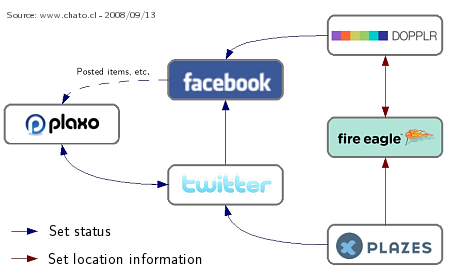Today I was playing with a few social networking applications that offer location services. Why? I want to stop posting only cryptic status messages in Facebook and sometimes really say what am I doing as my friends do (real friends, not only facebook friends), plus I also want to post some location information in my profile and keep track of trips.
One of the most important features to me was compatibility with FireEagle, which is a broker of location information to be used by other applications and social networking sites, that will give me a low entry/exit barrier. I also wanted something that can write to my Facebook profile, as I use Facebook a lot. The resulting setting was a non-trivial data flow that I had to draw to understand:

There are a few sites that are designed to handle location information in a social networking setting. The one I liked the most, from the ones I visited, is Dopplr which is a place for frequent travellers to boast about how many places they have been and where are they going next. Dopplr can read/write from FireEagle and has a nice application for Facebook. The Dopplr site is also pretty neat, I must say, and the Raumzeitgeist has a very cool look.
Then there is Plazes in which you can name a place, put it on the map, take a photo of it, etc. I like the "radar" function that can scan places around your location (it found that stupid club down the street the "Macarena" which is a tourist trap like many others in Barcelona). Now, Plazes has only write access to FireEagle, and that is too bad, BUT it can write to Twitter, which I found very good, given that I know a lot of people use Twitter, even some friends who are subscribed to my feed, but I haven't used it much. If I start using Plazes, then I will start using Twitter, that is 2 for the prize of 1.
 To tame a bit all this mess I also "use" Plaxo. I say "use" with quotes because I really do nothing there, just register a set of data sources, I like it a lot because it can aggregate very well from different sources: it reads the RSS feeds from my blogs/sites and also has hooks for delicious, Amazon, Flickr, last.fm and many other sites I use and like. It integrates very tightly with Twitter, as it can read/write the status line, and it reads the "posted items" in Facebook which are useful -- I usually see ~45 clicks briefly after posting an item.
To tame a bit all this mess I also "use" Plaxo. I say "use" with quotes because I really do nothing there, just register a set of data sources, I like it a lot because it can aggregate very well from different sources: it reads the RSS feeds from my blogs/sites and also has hooks for delicious, Amazon, Flickr, last.fm and many other sites I use and like. It integrates very tightly with Twitter, as it can read/write the status line, and it reads the "posted items" in Facebook which are useful -- I usually see ~45 clicks briefly after posting an item.
With respect to Facebook, Twitter and Dopplr have Facebook applications. The Twitter application can read Twitter status feeds and post them on Facebook, and the same with Dopplr.
A priori, I do not dislike complex stuff, I even like complicated things, but I do not want to spend a lot of time on this. Looking at the data graph to find if there is any source that can reach all the nodes, I see that if I post my location to Plazes it should propagate to the other services. I will try that, and after playing a bit, I will tell you how it went. Perhaps I can post an update to Facebook.
Or Twitter? Or Plaxo? Or somewhere else? :-)
Disclaimer: FireEagle is a service provided by the hand that feeds me.